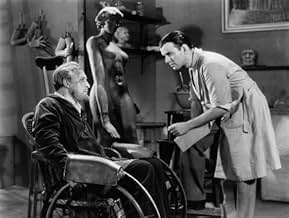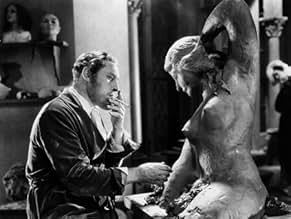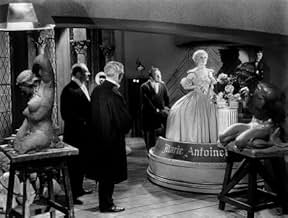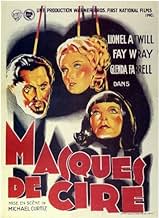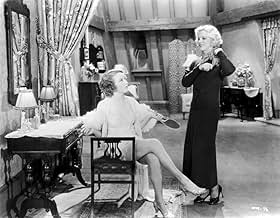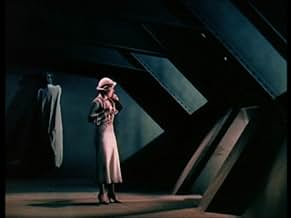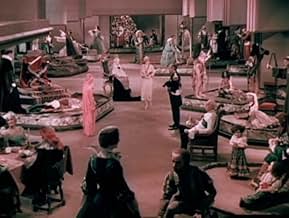PUNTUACIÓN EN IMDb
6,8/10
7,3 mil
TU PUNTUACIÓN
En un museo de cera, un curador enmascarado transforma a la gente en estatuas y busca a su siguiente María Antonieta.En un museo de cera, un curador enmascarado transforma a la gente en estatuas y busca a su siguiente María Antonieta.En un museo de cera, un curador enmascarado transforma a la gente en estatuas y busca a su siguiente María Antonieta.
- Dirección
- Guión
- Reparto principal
Thomas E. Jackson
- Detective
- (as Thomas Jackson)
Bull Anderson
- Janitor
- (sin acreditar)
Frank Austin
- Winton's Valet
- (sin acreditar)
Max Barwyn
- Museum Visitor
- (sin acreditar)
Wade Boteler
- Ambrose
- (sin acreditar)
Reseñas destacadas
This film, which was remade as "House Of Wax" 20 years later (as if you didn't know), might not enjoy quite the reputation it does today had it not been the basis for the better-known later film and, more importantly, believed lost for over 30 years, which made it something of a legend for many people who'd never even seen it. Legendary status can be rather difficult to live up to, and unless a viewer is approaching it with no advance knowledge of its history, MYSTERY OF THE WAX MUSEUM may not be quite what one expects.
It is, nevertheless, an energetic and entertaining amalgam of genres: horror film meets newspaper crime drama. Dropping a rather Gothic tale of body-snatching, a mad sculptor and a museum of wax-covered corpses into the streamline-moderne milieu of fast-talking, wise-cracking reporters on the trail of a hot story makes for interesting contrasts.
Lionel Atwill, as Ivan Igor, the artist driven to insanity and murder by the destruction of his wax "children" in an arson fire, was an immensely enjoyable performer whose best work came a bit later (see "Son Of Frankenstein" for his portrayal of the one-armed Insp. Krogh). His natural screen presence carries him through, though he never quite generates either the pathos or the smooth menace that Vincent Price displayed in the remake. But from the moment of her entrance, it's Glenda Farrell as Florence Dempsey, the reporter out to save her job by bringing in a scoop - barreling onto the screen with a full head of steam - who propels the story all the way to its finish.
There's an awful lot going on here beyond the basic premise; bootlegging, a "dope fiend," a suicide and a falsely implicated millionaire playboy are thrown into the mix, packing quite a lot into the 77 minute running time (the remake improved the story by eliminating extraneous characters and subplots). A pre-"King Kong" Fay Wray (in her naturally red hair sans the "Kong" blond wig) is the damsel in actual distress, but despite her billing, she's basically a supporting player and has little to do - beyond enduring roommate Florence's snide comments about her penniless boyfriend - until the climactic confrontation between all the bad guys and good guys (and girls).
MYSTERY is well-served by the direction of Michael Curtiz ("Adventures Of Robin Hood," "Casablanca"), who was something of a jack-of-all-genres, and there's plenty of snappy dialogue, some of which (Florence asking a cop, "How's your sex life?") wouldn't have made it to the screen a year later under the newly re-written Production Code. Depending on one's point of view, it could be said that the very effective production design either benefits, or suffers, from the pale pastels of the two-strip Technicolor photography. For my part, I'm guessing that the subdued tones we see today result from the lack of first-rate film elements available. Having seen far superior two-strip from years earlier, I'll wager that the original prints were much more vivid.
If you're any kind of a fan of the remake, you do owe it to yourself to see this one, if only once. There are many things to enjoy in MYSTERY OF THE WAX MUSEUM, not the least of which are the fabulous ensembles worn by Farrell. Just how does a newspaper reporter one step away from the breadline afford a wardrobe like that?
It is, nevertheless, an energetic and entertaining amalgam of genres: horror film meets newspaper crime drama. Dropping a rather Gothic tale of body-snatching, a mad sculptor and a museum of wax-covered corpses into the streamline-moderne milieu of fast-talking, wise-cracking reporters on the trail of a hot story makes for interesting contrasts.
Lionel Atwill, as Ivan Igor, the artist driven to insanity and murder by the destruction of his wax "children" in an arson fire, was an immensely enjoyable performer whose best work came a bit later (see "Son Of Frankenstein" for his portrayal of the one-armed Insp. Krogh). His natural screen presence carries him through, though he never quite generates either the pathos or the smooth menace that Vincent Price displayed in the remake. But from the moment of her entrance, it's Glenda Farrell as Florence Dempsey, the reporter out to save her job by bringing in a scoop - barreling onto the screen with a full head of steam - who propels the story all the way to its finish.
There's an awful lot going on here beyond the basic premise; bootlegging, a "dope fiend," a suicide and a falsely implicated millionaire playboy are thrown into the mix, packing quite a lot into the 77 minute running time (the remake improved the story by eliminating extraneous characters and subplots). A pre-"King Kong" Fay Wray (in her naturally red hair sans the "Kong" blond wig) is the damsel in actual distress, but despite her billing, she's basically a supporting player and has little to do - beyond enduring roommate Florence's snide comments about her penniless boyfriend - until the climactic confrontation between all the bad guys and good guys (and girls).
MYSTERY is well-served by the direction of Michael Curtiz ("Adventures Of Robin Hood," "Casablanca"), who was something of a jack-of-all-genres, and there's plenty of snappy dialogue, some of which (Florence asking a cop, "How's your sex life?") wouldn't have made it to the screen a year later under the newly re-written Production Code. Depending on one's point of view, it could be said that the very effective production design either benefits, or suffers, from the pale pastels of the two-strip Technicolor photography. For my part, I'm guessing that the subdued tones we see today result from the lack of first-rate film elements available. Having seen far superior two-strip from years earlier, I'll wager that the original prints were much more vivid.
If you're any kind of a fan of the remake, you do owe it to yourself to see this one, if only once. There are many things to enjoy in MYSTERY OF THE WAX MUSEUM, not the least of which are the fabulous ensembles worn by Farrell. Just how does a newspaper reporter one step away from the breadline afford a wardrobe like that?
Michael Curtiz has over 170 directing credits, including "The Jazz Singer." Of the films on that list which I have seen, this is my favourite. It's filled with some quite amazing dolly and camera work, the story is fun and the acting is solid.
This story has had a long life. This film, was based on a play. In 1953, it was re-made as a Vincent Price vehicle, "House of Wax" in 3-D. And in 2005, it was re-made again as a teen slasher. The premise is solidly creepy.
Glenda Farrell is hilarious as the young journalist. Her energy leaps off the screen. I guess audiences of 1933 needed quite a bit of comic relief to make it through the rest of this.
Lionel Atwill's make-up is fantastic. It's no surprise that it was designed by a Westmore: Hollywood's premiere make-up family.
This was shot in a two-colour Technicolor process which makes the entire film rather distinctive and moody. The fantastic film noir lighting adds to it as well.
If you can find this, it's a definite must-see! There are so many images and ideas borrowed from it in later horror films it's interesting to see their origins.
This story has had a long life. This film, was based on a play. In 1953, it was re-made as a Vincent Price vehicle, "House of Wax" in 3-D. And in 2005, it was re-made again as a teen slasher. The premise is solidly creepy.
Glenda Farrell is hilarious as the young journalist. Her energy leaps off the screen. I guess audiences of 1933 needed quite a bit of comic relief to make it through the rest of this.
Lionel Atwill's make-up is fantastic. It's no surprise that it was designed by a Westmore: Hollywood's premiere make-up family.
This was shot in a two-colour Technicolor process which makes the entire film rather distinctive and moody. The fantastic film noir lighting adds to it as well.
If you can find this, it's a definite must-see! There are so many images and ideas borrowed from it in later horror films it's interesting to see their origins.
A genuinely frightening film from Michael Curtiz, jack of no trades and master of all. Many of the tricks of classic 1930's horror are here, including the opening scene set in a dark, rainy London street, the long shadows on the wall, lengthy periods of silence, and all timed to perfection. Only the faster-than-the-speed-of-sound dialogue of Glenda Farrell truly lets the film down. But other than that it is a gothic masterpiece, an underrated movie probably due to the fact that it lay undiscovered, thought lost, for over half a century. Far more inventive and imaginative than the majority of horror films made today.
These days, Mystery of the Wax Museum has become best known for the fact that it was the film that spawned the 1953 classic starring Vincent Price. This is somewhat unfair, however, as although this film isn't a brilliant masterpiece, or even genre classic, it has a right to remembered in it's own right. The film is actually quite daring and inventive for the time when it was made; and despite the fact that nothing too bad is graphically shown, for obvious reasons, some of the imagery on display does actually succeed in being quite disturbing. Take the deformed face of the central character for example; it won't keep you up all night, but considering the time when this was made; the effects are good. The two-strip Technicolor style of the film gives it something of a unique feel; and this again is to it's credit as the film has aged really, really well. The plot line will be familiar to anyone who has seen the Vincent Price version, but here, aside from a museum proprietor that gets his life work melted away in an inferno; we've got a press investigation into the affairs as well.
Lionel Atwill takes the lead role as the unfortunate victim of the flames, and while he's certainly no Vincent Price; he does well with what he's got and helps to create a macabre surrounding around his character, which in turn helps the film in the atmosphere department. Joining him are Glenda Farrell and Fay Wray as the heroine's of the story. Wray plays the girl that the unfortunate artist becomes obsessed with, and Farrell gives a slightly irritating, but very lively performance as a journalist. Both do well with their roles, and although this film isn't exactly an exhibition in acting (unlike Curtiz's masterpiece, Casablanca); the cast do well enough. One thing that is unfortunate for this film is that it's seen as a second feature for the Price version, which will harm what some viewers think of it as the plot elements are very similar to the 1953 film, so it can, at times, feel as though you're simply watching the same film again. However, if viewed as a stand-alone product, Mystery of the Wax Museum represents a solid 30's horror movie and I can see why any horror fan wouldn't enjoy it.
Lionel Atwill takes the lead role as the unfortunate victim of the flames, and while he's certainly no Vincent Price; he does well with what he's got and helps to create a macabre surrounding around his character, which in turn helps the film in the atmosphere department. Joining him are Glenda Farrell and Fay Wray as the heroine's of the story. Wray plays the girl that the unfortunate artist becomes obsessed with, and Farrell gives a slightly irritating, but very lively performance as a journalist. Both do well with their roles, and although this film isn't exactly an exhibition in acting (unlike Curtiz's masterpiece, Casablanca); the cast do well enough. One thing that is unfortunate for this film is that it's seen as a second feature for the Price version, which will harm what some viewers think of it as the plot elements are very similar to the 1953 film, so it can, at times, feel as though you're simply watching the same film again. However, if viewed as a stand-alone product, Mystery of the Wax Museum represents a solid 30's horror movie and I can see why any horror fan wouldn't enjoy it.
MYSTERY OF THE WAX MUSEUM (Warner Brothers, 1933), reunites director Michael Curtiz with his DOCTOR X (First National, 1932) co-stars, Lionel Atwill and Fay Wray, in another two-strip Technicolor horror/comedy mystery. A carbon copy of DOCTOR X with a few alterations and improvements thrown in, it ranks the finest and most noteworthy of the Atwill-Fay collaborations (1933's THE VAMPIRE BAT for Majestic was their second), as well as the most eerie and mysterious of them all. While Atwill and Wray had equal status in their initial two outings, Atwill this time dominates while Wray, interestingly, has little to do, not making her screen presence until 30 minutes from the opening titles. She's gone for long stretches and is not visible in the fade-out while Glenda Farrell, the secondary female character, comes close to being the lead, or so it appears. Regardless of Wray's limitations, her character is quite crucial to the story and to Atwill's mentally unbalanced character.
Opening with a prologue set in 1921 London introduces Ivan Igor (Lionel Atwill) as a brilliant sculptor of wax figures of noteworthy figures as Joan of Arc, Jack the Ripper, Disraeli, and his most favorite, Marie Antoinette, hoping for his museum to become successful once it opens to the public. Because he's invested more money than anticipated, Joe Worth (Edwin Maxwell), his partner whom he owes back salary, comes upon a plan to get back some of his investment by burning down the museum and collect on the fire insurance. A fight ensues between the two partners, with Worth breaking away, locking Igor inside the museum surrounded by flames where he's left to burn along with his wax figures. Move forward, New Year's Eve, 1933, in New York City. Ivan, who has survived the burning flames, is wheelchair bound. Unable to recreate his wax figures due to his severely burned hands, he hires assistants, Ralph (Allen Vincent); D'Arcy (Arthur Edmund Carewe) and Hugo (Matthew Betz) to sculpt wax figures for him under his supervision. Successfully reproducing his original creations, Igor is unable to do the same with Marie Antoinette, that is, until he meets her replica, Charlotte Duncan (Fay Wray), Ralph's fiancée. In the meantime, a series of murders have taken place with bodies mysteriously disappearing from the morgue from some figure in a cloak. Millionaire playboy Harold Ritten (Gavin Gordon), who happened to be with Joan Gale on the night of her murder, is suspected and jailed. Florence Parks (Glenda Farrell), Charlotte's roommate and gal reporter for the New York Express, is assigned by her editor (Frank McHugh) to investigate. Following her interview with Harold leading to her constant snooping around Igor's 14th Street wax museum, she discovers something quite startling in connection to the murder, hence "the mystery of the wax museum."
If the story sounds at all familiar, it was reworked more famously as HOUSE OF WAX (Warners, 1954) starring Vincent Price in the Atwill role. Due to the popularity of the remake, the original from which it was based, was virtually unknown, especially since no prints of MYSTERY OF THE WAX MUSEUM have survived. Fortunately, an original print was discovered, according to sources, in Jack L. Warner's private vault around the late 1960s. WAX MUSEUM finally turned up on commercial television, notably on New York City's WPIX, Channel 11's "Chiller Theater" on February 10, 1973, where it broadcast annually until 1978, only in black and white format only. It would be another decade before two-strip Technicolor prints surfaced and distributed on home video and DVD, with broadcasts on Turner Network Television (1988-1993) and finally Turner Classic Movies (1994-present).
With Glenda Farrell assuming the wisecracking reporter role Lee Tracy enacted in DOCTOR X, her performance in this venture seems right and warranted, improving over Tracy's lackluster buffoonery. Even if Farrell's character disappoints, the script does not and neither does Atwill. Who could forget his key scenes as the bearded Igor conversing with his favorite wax figure of Marie Antoinette, and his outlook as he witnesses the melting of his "children" in a blazing fire (very realistically done and effective in color), along with his unforgettable confrontation with the screaming Wray as he offers her "eternal life" in the manner that would have done 1925s "Phantom of the Opera" star Lon Chaney proud had he lived to see this.
In some ways, THE MYSTERY OF THE WAX MUSEUM is perfect, in others it's not, but must have been good enough to acquire a remake, find the missing negative for the original and have it displayed as one of the finer horror classics to come out from the 1930s. (**1/2)
Opening with a prologue set in 1921 London introduces Ivan Igor (Lionel Atwill) as a brilliant sculptor of wax figures of noteworthy figures as Joan of Arc, Jack the Ripper, Disraeli, and his most favorite, Marie Antoinette, hoping for his museum to become successful once it opens to the public. Because he's invested more money than anticipated, Joe Worth (Edwin Maxwell), his partner whom he owes back salary, comes upon a plan to get back some of his investment by burning down the museum and collect on the fire insurance. A fight ensues between the two partners, with Worth breaking away, locking Igor inside the museum surrounded by flames where he's left to burn along with his wax figures. Move forward, New Year's Eve, 1933, in New York City. Ivan, who has survived the burning flames, is wheelchair bound. Unable to recreate his wax figures due to his severely burned hands, he hires assistants, Ralph (Allen Vincent); D'Arcy (Arthur Edmund Carewe) and Hugo (Matthew Betz) to sculpt wax figures for him under his supervision. Successfully reproducing his original creations, Igor is unable to do the same with Marie Antoinette, that is, until he meets her replica, Charlotte Duncan (Fay Wray), Ralph's fiancée. In the meantime, a series of murders have taken place with bodies mysteriously disappearing from the morgue from some figure in a cloak. Millionaire playboy Harold Ritten (Gavin Gordon), who happened to be with Joan Gale on the night of her murder, is suspected and jailed. Florence Parks (Glenda Farrell), Charlotte's roommate and gal reporter for the New York Express, is assigned by her editor (Frank McHugh) to investigate. Following her interview with Harold leading to her constant snooping around Igor's 14th Street wax museum, she discovers something quite startling in connection to the murder, hence "the mystery of the wax museum."
If the story sounds at all familiar, it was reworked more famously as HOUSE OF WAX (Warners, 1954) starring Vincent Price in the Atwill role. Due to the popularity of the remake, the original from which it was based, was virtually unknown, especially since no prints of MYSTERY OF THE WAX MUSEUM have survived. Fortunately, an original print was discovered, according to sources, in Jack L. Warner's private vault around the late 1960s. WAX MUSEUM finally turned up on commercial television, notably on New York City's WPIX, Channel 11's "Chiller Theater" on February 10, 1973, where it broadcast annually until 1978, only in black and white format only. It would be another decade before two-strip Technicolor prints surfaced and distributed on home video and DVD, with broadcasts on Turner Network Television (1988-1993) and finally Turner Classic Movies (1994-present).
With Glenda Farrell assuming the wisecracking reporter role Lee Tracy enacted in DOCTOR X, her performance in this venture seems right and warranted, improving over Tracy's lackluster buffoonery. Even if Farrell's character disappoints, the script does not and neither does Atwill. Who could forget his key scenes as the bearded Igor conversing with his favorite wax figure of Marie Antoinette, and his outlook as he witnesses the melting of his "children" in a blazing fire (very realistically done and effective in color), along with his unforgettable confrontation with the screaming Wray as he offers her "eternal life" in the manner that would have done 1925s "Phantom of the Opera" star Lon Chaney proud had he lived to see this.
In some ways, THE MYSTERY OF THE WAX MUSEUM is perfect, in others it's not, but must have been good enough to acquire a remake, find the missing negative for the original and have it displayed as one of the finer horror classics to come out from the 1930s. (**1/2)
¿Sabías que...?
- CuriosidadesThis film was produced before the Production Code. When it was remade 20 years later, as Los crímenes del museo de cera (1953), all references to drug use were removed, and a character was changed from a junkie to an alcoholic.
- PifiasIvan Igor says that Jean Paul Marat's assassin, Charlotte Corday, was his mistress. This is incorrect; they never had met until she came to his office posing as a courier and quickly stabbed him to death. After her execution a few days later, she was found to be virgo intacta.
- Versiones alternativasThis film was shot in two versions. One camera unit shot the film in two-color Technicolor. A second camera unit shot the scenes at the same time in black and white. The black and white version was meant for theaters who could not afford the higher rental cost of the color prints.
- ConexionesEdited into Ante todo, mujer (1974)
Selecciones populares
Inicia sesión para calificar y añadir a tu lista para recibir recomendaciones personalizadas
- How long is Mystery of the Wax Museum?Con tecnología de Alexa
- What is 'The Mystery of the Wax Museum' about?
- Is 'The Mystery of the Wax Museum' based on a book?
- When does the movie take place?
Detalles
- Duración1 hora 17 minutos
- Relación de aspecto
- 1.37 : 1
Contribuir a esta página
Sugerir un cambio o añadir el contenido que falta

Principal laguna de datos
By what name was Los crímenes del museo (1933) officially released in India in English?
Responde

